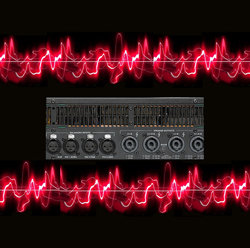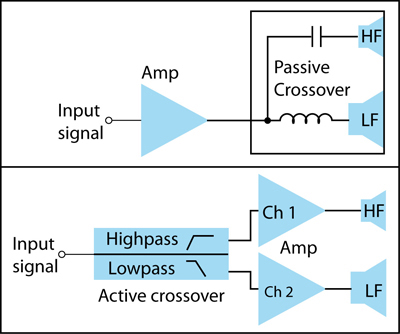
Real-world amps provide something like 3X the power in bridge mode because the amount of current available is limited.
Bridged amps should be used with loudspeaker impedances that are twice the minimum rated impedance in non-bridged mode.
For example, if an amp is rated at 4 ohms minimum in stereo mode, the load for bridge-mono operation should be 8 ohms minimum. Avoid driving a 4-ohm load with a bridged amp unless the specs say that the amp can handle it.
Bridging a stereo amp effectively turns it into a mono amp. So if you want to use two loudspeakers in a system, you’ll need two bridged stereo amplifiers.
Feed each amp a single mono input signal. In a stereo system, you’d feed the left-channel signal to amp 1 and feed the right-channel signal to amp 2.
Because the output signals of a bridged amplifier are floating, you should not connect an amplifier output terminal to a grounded device. That shorts one channel and may blow the amp.
Bi-Amping
Here’s our final topic. A single amplifier-loudspeaker system uses one amplifier channel driving a loudspeaker with an internal passive crossover.
Operating at high power, that crossover filter sends the lows to the woofer and the highs to the high-frequency driver.
In a bi-amplified sound system, you use one amplifier for the woofer(s) and another for the high frequency driver(s). An active crossover sends the lows to one amp channel and the highs to the other amp channel.
Each channel covers a specific frequency band, not the entire audio range. With a single-amp system, one amplifier handles the complete audio range (Figure 3).
.
Some systems can be tri-amplified, and some touring systems are four-way or five-way. They are the norm for high-power systems.
The advantages of bi-amplification include:
• Distortion frequencies caused by clipping the woofer power amplifier will not reach the tweeter, so there is less likelihood of tweeter burnout if the amplifier clips. In addition, clipping distortion in the woofer amplifier is made less audible because the woofer can’t reproduce high frequencies.
• Intermodulation distortion is reduced.
• Direct coupling of amplifiers to loudspeakers improves transient response – especially at low frequencies.
• Bi-amping reduces the inductive and capacitive loading of the power amplifier by a passive crossover.
• The full power of the tweeter amp is available regardless of the power required by the woofer amp.
• The active crossover can be variable frequency, so it adapts to a wide range of loudspeaker systems. It also lets you control the level and polarity of various drivers.
• The active crossover can have steeper roll-offs. This protects loudspeakers by keeping out unwanted frequencies.
• You omit the non-linear passive LF crossover used in passive loudspeakers. The result is higher sound quality.
• Peak power output is greater than that of a single amplifier of equivalent power.
Let’s explain that last advantage in more detail. Suppose you have an 800-watt single amplifier, and also a 600-watt LF amp and 200-watt HF amp as part of a bi-amped setup.
In general, you can get more volume – higher peak levels – from the bi-amped system even though the two systems have the same total power. A loud bass note and a loud high-frequency note sounding simultaneously might clip the 800-watt single amp.
But since the bi-amped system is split into low and high bands, each amp is more likely to pass the signal without clipping.
As we’ve seen, there are many aspects of amplifier power to understand. The more you know about the nuances, the higher your skill level as an audio professional.
Bruce Bartlett is a microphone engineer (http://www.bartlettmics.com), an audio journalist, and a recording enginee (www.bartlettrecording.com). He is the author of “Practical Recording Techniques 5th Edition” and “Recording Music On Location”.

